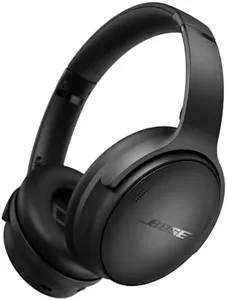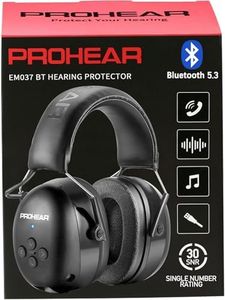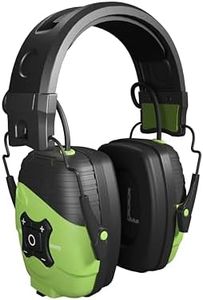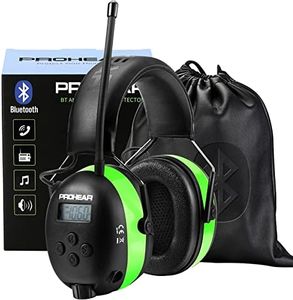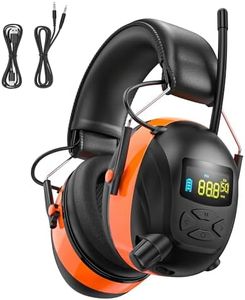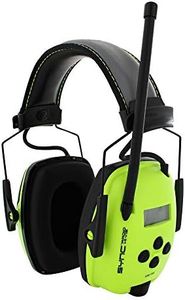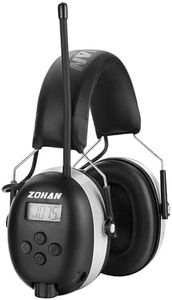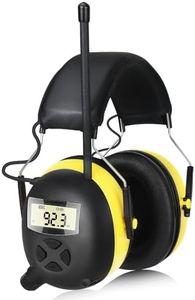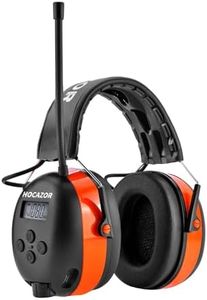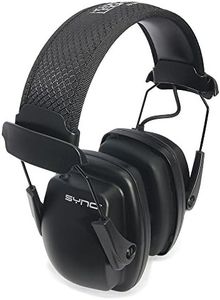We Use CookiesWe use cookies to enhance the security, performance,
functionality and for analytical and promotional activities. By continuing to browse this site you
are agreeing to our privacy policy
10 Best Radio Headphones For Mowing
From leading brands and best sellers available on the web.Buying Guide for the Best Radio Headphones For Mowing
Choosing radio headphones for mowing can make your outdoor chores much more enjoyable and safe. The right pair will protect your hearing from the noise of lawnmowers while allowing you to listen to music or the radio. It’s important to consider comfort, noise reduction, sound quality, battery life, and additional features that suit outdoor use. Understanding your specific needs, such as how long you’ll wear them or if you want to answer calls, will help you decide which features matter most for you.Noise Reduction Rating (NRR)Noise Reduction Rating, or NRR, tells you how much sound the headphones can block out. This spec is crucial because mowing machines are loud, and prolonged exposure can damage your hearing. NRR is measured in decibels (dB). Lower ratings (around 15–20 dB) offer basic protection, suitable for quieter environments. Mid-range (20–27 dB) is good for most home mower users, providing solid noise isolation. High NRR (28 dB and above) is best for very loud equipment or longer mowing sessions. If you’re using a standard home mower, mid-range NRR is typically enough, but if you’re exposed to louder machinery or value extra quietness, go higher.
Comfort and FitComfort and fit are about how the headphones feel during use, especially when wearing them for hours. This depends on the padding of the ear cups, the adjustability of the headband, and the overall weight of the headphones. Lightweight models with thick, soft padding are less likely to cause pressure or sweat. For occasional, short mowing sessions, less padding may suffice, but for long mowing or if you have sensitive ears, prioritize models known for comfort and adjustability.
Radio Reception and TuningRadio reception and tuning determine how well the headphones pick up FM or AM stations and how easy it is for you to choose a station. Some headphones have basic manual tuning, while others offer digital tuning and presets. If you just want to listen to one or two local stations, basic tuning might be enough. If you like to frequently switch channels or save your favorites, digital tuning and presets make it quicker and more convenient.
Bluetooth ConnectivityBluetooth connectivity means you can connect the headphones wirelessly to your phone or other devices to enjoy music, podcasts, or take calls. Not all radio headphones include this feature. If you want your audio options to extend beyond traditional radio—like streaming apps or hands-free calls—look for models with Bluetooth. If you only plan to listen to built-in radio, Bluetooth might not be necessary.
Battery LifeBattery life refers to how long the headphones can operate before needing a recharge or new batteries. Some run on built-in rechargeable batteries, others use standard AA or AAA batteries. For short mowing tasks, battery life isn’t as critical, but if you mow large areas or prefer not to recharge often, choose a model with longer battery life. Consider whether you prefer the convenience of regular batteries (easy to swap) or the cost savings and eco-friendliness of rechargeables.
Durability and Weather ResistanceDurability and weather resistance describe how well the headphones can handle outdoor conditions like dust, sweat, rain or even occasional drops. Rugged models with splash-resistant or water-resistant ratings are better for sweating or if you get caught in light rain. For casual or occasional outdoor work, basic durability might be enough, but for frequent or heavy-duty use, prioritize more robust, water-resistant designs.
Sound QualitySound quality determines how pleasant and clear the audio from your music or radio sounds. While mowing, perfection isn’t necessary since the main goal is protection and entertainment, but if you enjoy clear music or talk shows, check for models that mention good bass, crisp highs, or balanced sound. If you’re less picky and just want background noise, only basic sound quality is required.
